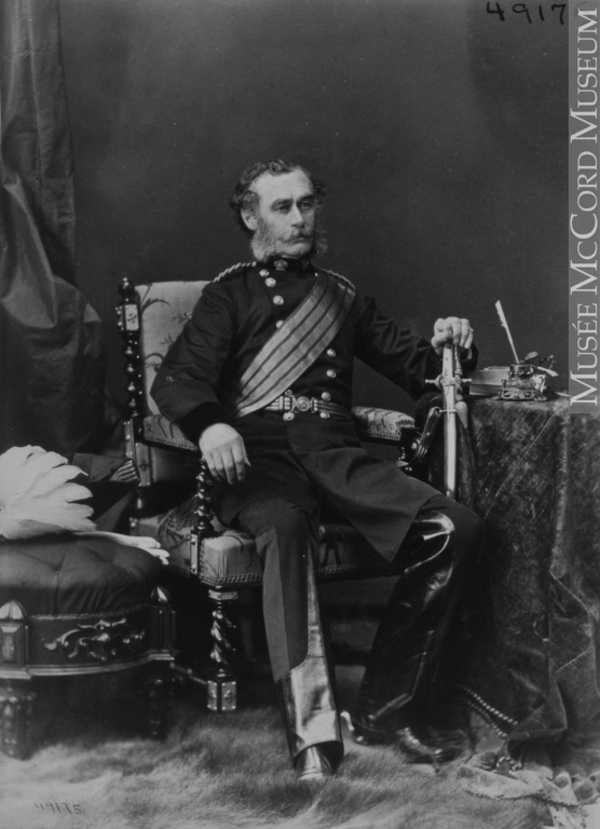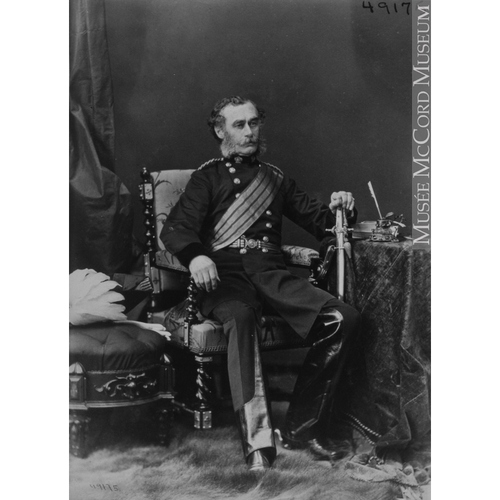
Source: Link
LINDSAY, Sir JAMES ALEXANDER, soldier; b. 25 Aug. 1815 at Muncaster Castle, Cumberland, Eng., second son of James Lindsay, 7th Earl of Balcarres and 24th Earl of Crawford, and of the Hon. Maria Margaret Frances Pennington, daughter of John Pennington, 1st Baron Muncaster; d. 13 Aug. 1874, at Mitcham, Surrey, Eng.
James Alexander Lindsay was educated at Eton College and entered the Grenadier Guards by purchase on 16 March 1832. He advanced by purchase to the rank of lieutenant and captain in 1836 and then to captain and lieutenant-colonel in 1846. From 1838 to 1842 he was adjutant of the 3rd battalion of his regiment in Canada.
In 1845, James Lindsay entered parliament for the borough of Wigan, where the family seat was located. He supported Sir Robert Peel on free trade but remained a Conservative until he gave up his seat in 1865. Meanwhile, he rose steadily in rank, becoming lieutenant-colonel of the Grenadier Guards in 1860 and, on 12 March 1861, being promoted major-general. Advancement came apparently without his hearing a shot fired in anger. On 6 Nov. 1845, Lindsay married Lady Sarah Elizabeth Savile, daughter of John, 3rd Earl of Mexborough. Two sons died in infancy but three daughters survived. Lady Sarah became woman of the bedchamber to Queen Victoria.
In 1861, with the United States and Britain on the brink of war, General Lindsay accompanied the reinforcements rushed to the British garrison in Canada. He was given command of the troops in the lower province (Canada East). Colonel Garnet Joseph Wolseley*, then a staff officer at Montreal, remembered Lindsay as “an able, energetic soldier, whose heart was in his work, and one of the most charming men I ever knew,” adding that he was “as great a favourite with the Canadians as he was with the troops.”
In 1866 Lindsay returned to England, taking command of the battalions of foot guards in London and then receiving the appointment of inspector general of reserve forces. William Ewart Gladstone’s government took office in England in 1868, and its secretary of state for war, Edward Cardwell, was bent on eliminating British garrisons in self-governing colonies. The task of dismantling more than a century of unbroken British military presence in Canada proved too much for the lieutenant-general commanding in British North America, Sir Charles Ash Windham*, who died on 2 Feb. 1870. Command devolved on Major-General Sir Charles Hastings Doyle*, the British commander at Halifax, but the War Office decided to send another officer to wind up the British garrisons in central Canada.
Lindsay accepted the task, was given local rank as lieutenant-general, and on 5 April 1870 arrived in Montreal to take command of the remaining troops in Ontario and Quebec. His first task, according to his instructions, was to cooperate with the Canadian government in providing a force to secure the transfer of the Red River colony to the dominion. The Canadians arranged supplies and transport, raised two battalions of militia, and paid three-quarters of the cost; Lindsay chose the commander, Colonel Garnet Wolseley, gave him his orders, and oversaw the arrangements. “I felt from the first,” he explained to Cardwell, “that the Force, though mixed, was an Imperial one and that I was responsible for everything connected with it.” The assumption led to friction with the Canadian authorities and to complaints from Lindsay of Canadian mismanagement and political interference, particularly in relation to the recruiting of a Quebec rifle battalion and the failure to make arrangements for transportation to Lake Superior.
Lindsay was also instructed to help the Canadians develop their own military institutions. He advanced a number of practical suggestions to the Canadian ministers: they could hire a British regiment; they could recruit their own force from disbanded British soldiers; they could organize mounted patrols and man gunboats to prevent Fenian attacks. Looking beyond the immediate problem, Lindsay wanted to guarantee that Canadian forces “would be organized upon the same system as those of the United Kingdom.” His most insistent recommendation was the appointment of a British general to command the Canadian militia. Canadian ministers took little heed of Lindsay’s advice, though many of his proposals were eventually adopted.
At the end of May 1870 the long-heralded Fenian threat manifested itself in two feeble thrusts across the Quebec border [see John O’Neill]. Though the Fenians were easily repelled, 13,489 Canadian militiamen were mobilized and placed at Lindsay’s disposal.
By September Lindsay had closed most of the British military establishments in central Canada and had concentrated the remnants at Quebec. The British troops in the Red River expedition were returning from Fort Garry (Winnipeg). On 24 September, Lindsay’s appointment ended with the closing of the British military headquarters at Montreal. The War Office was now anxious for him to return to his duties with the reserve forces. Both Cardwell and the colonial secretary, John Wodehouse, 1st Earl of Kimberley, were pleased with his service in Canada, and their satisfaction was demonstrated by a knighthood in the new order of St Michael and St George, confirmation in the rank of lieutenant-general, and the colonelcy of the 3rd Foot (The Buffs). Lindsay was still holding the appointment of inspector general of reserve forces when he died.
PAC, RG 8, I, A2, 1287, pp.419–503. PRO, CO 42/693, pp.230ff.; WO 32/813/058/316. Returns of addresses of the Senate and House of Commons, relative to the withdrawal of the troops from the dominion and of the defence of the country and Honorable Mr Campbell’s report (Ottawa, 1871). Kenneth Bourne, Britain and the balance of power in North America, 1815–1871 (London, 1967), 295–302. J. M. Hitsman, Safeguarding Canada, 1763–1871 (Toronto, 1968), 133–43, 208–23. Desmond Morton, Ministers and generals; politics and the Canadian militia, 1868–1904 (Toronto, 1970). C. P. Stacey, Canada and the British Army, 1846–1871 (2nd ed., Toronto, 1963), 204–63. Desmond Morton, “French Canada and the Canadian militia,” SH, no.3 (1969), 36.
Cite This Article
Desmond Morton, “LINDSAY, Sir JAMES ALEXANDER,” in Dictionary of Canadian Biography, vol. 10, University of Toronto/Université Laval, 2003–, accessed March 30, 2025, https://www.biographi.ca/en/bio/lindsay_james_alexander_10E.html.
The citation above shows the format for footnotes and endnotes according to the Chicago manual of style (16th edition). Information to be used in other citation formats:
| Permalink: | https://www.biographi.ca/en/bio/lindsay_james_alexander_10E.html |
| Author of Article: | Desmond Morton |
| Title of Article: | LINDSAY, Sir JAMES ALEXANDER |
| Publication Name: | Dictionary of Canadian Biography, vol. 10 |
| Publisher: | University of Toronto/Université Laval |
| Year of revision: | 1972 |
| Access Date: | March 30, 2025 |



